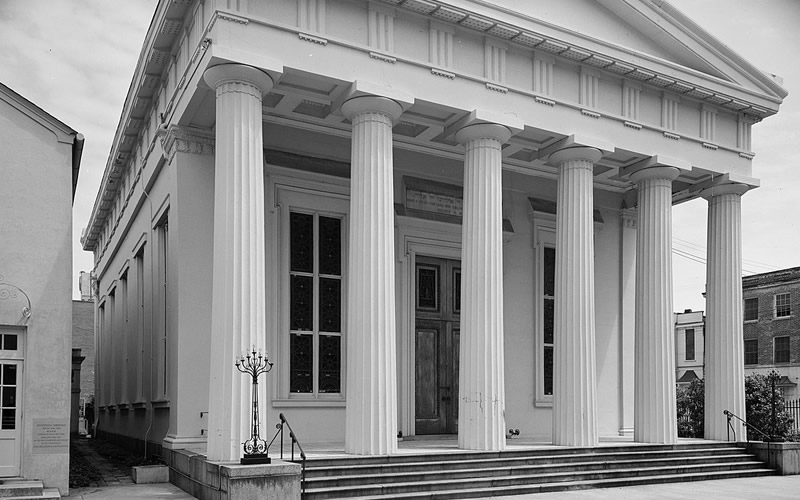S.C. Encyclopedia | Following the Revolutionary War, South Carolina’s Jewish population surged. When Columbia became the state capital in 1786, seven Jewish men from Charleston were among the first to buy town lots.
Jews arrived in the British colony of Carolina with the first wave of European settlement. A new outpost in the mercantile traffic of the Atlantic basin, Carolina offered economic opportunities, as well as risks, and a degree of religious tolerance remarkable for the time. The colony’s Fundamental Constitutions of 1669 granted freedom of worship to “Jews, Heathens, and other Dissenters from the purity of the Christian Religion.” Although the colonial assembly never endorsed the provision, British Charleston became known as a place where people of all faiths—except Catholics—could do business and practice their religion without interference. In 1696 Jews in Charleston allied with French Huguenots to safeguard their rights to trade and the next year to secure citizenship.
Most of Carolina’s first Jewish settlers traced their roots to Spain or Portugal. Expelled during the Inquisition at the end of the fifteenth century, the Sephardim (from the Hebrew word for Spain) dispersed around the globe and established themselves in capitals and port cities in northern Europe, the Mediterranean, and the West Indies. In 1749 Charleston’s Jewish community chartered Kahal Kadosh Beth Elohim—one of the first five Jewish congregations in America. Like her sister synagogues in New York, Newport, Savannah, and Philadelphia, Beth Elohim was Sephardic in ritual and practice. Charleston’s congregation remained so for two generations after the Revolutionary War, though by then the majority of South Carolina Jews were Ashkenazic, hailing from central or eastern Europe.
Following the Revolutionary War, South Carolina’s Jewish population surged. When Columbia became the state capital in 1786, seven Jewish men from Charleston were among the first to buy town lots. Jews in Georgetown, Beaufort, and Camden belonged to the business and civic elites. By 1800 Charleston was home to the largest, wealthiest, and most cultured Jewish community in North America—upwards of five hundred individuals, or one-fifth of all Jews in the nation.
Carolina’s Jews pursued the same material goals and status symbols as their white neighbors. Those who could afford it owned slaves. The affluent lived in finely furnished houses and traveled abroad. Many Ashkenazim adopted traditional Sephardic practices and assumed an aristocratic view of themselves as “earliest to arrive.”
Charleston’s highly acculturated Jewish community produced the first movement to reform Judaism in America. In 1824 a group of young, mostly American-born Jews petitioned the governing body of
Kahal Kadosh Beth Elohim for shorter services, a sermon preached on the Sabbath, and prayers in English. Rebuffed in their efforts, the dissidents drafted a constitution and established the Reformed Society of Israelites. For eight years the reformers worshiped separately, then returned to the traditional congregation. In 1840 the reform faction prevailed. With the blessing of Beth Elohim’s popular minister, Gustavus Poznanski, a proposal to install an organ in the synagogue was adopted by a narrow margin. The traditionalists seceded and formed Shearit Israel (Remnant of Israel), with its own burying ground adjacent to Beth Elohim’s Coming Street cemetery. A brick wall separated the dead of the two congregations.
While schism in Beth Elohim divided traditionalists and reformers, a new group of immigrants introduced another brand of orthodoxy to Charleston. People of modest means—peddlers, artisans, metalworkers, bakers—these newcomers from eastern Europe gave the city’s Jewish population a more foreign appearance than before. As early as 1852, a minyan, or prayer group, began meeting under the leadership of Rabbi Hirsch Zvi Levine, recently arrived from Poland. In 1855 they formally organized as Berith Shalome (now Brith Sholom) or “Covenant of Peace”—the first Ashkenazic congregation in South Carolina and one of the first in the South.
— Excerpted from an entry by Dale Rosengarten. To read more about this or 2,000 other entries about South Carolina, check out The South Carolina Encyclopedia, published in 2006 by USC Press. (Information used by permission.)




 We Can Do Better, South Carolina!
We Can Do Better, South Carolina!
























